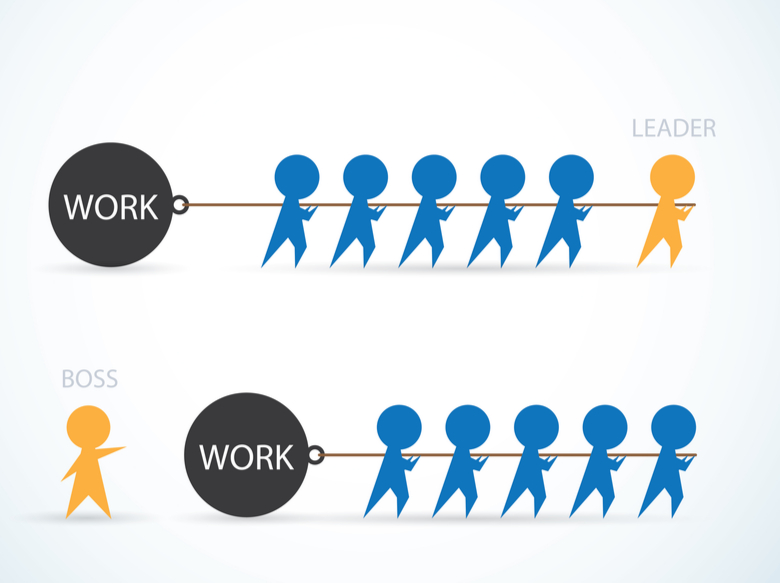What is leadership, and what is it to be just management?
Leaders guide and inspire. Bosses are more functionarial, merely managing tasks and keeping count of basic outputs, vs. creating value. Leaders influence. Bosses exert authority. The motivations of leader vs boss manifest in their behaviours toward employees. A leader aims at guiding the organisation to success by elevating performances and methods, to produce desired outcomes. Bosses are focused on imposing consequences for mistakes and failures. At most, bosses can compel cooperation, whereas leaders can motivate people to strive for excellence. Here are some essential distinctions between leaders and bosses:
1. Leaders see themselves as part of the team. Bosses see the team as a tool for success.
The team with good leadership has a sense of shared purpose. Everyone is pulling together to find solutions and reach goals. People under control of a boss often feel disengaged and are just putting in the required hours.
BOSS: Bosses talk as if the team is just an extension of themselves. The boss says, things like, “I can reach my goal, if my workers don’t fall behind.”
LEADER: Leaders talk like members of the team. They say things like, “We can reach our goal, if we can keep up our current pace.”
Practice: Let people know that you understand you’re a member of the team. Talk to the team about what “we” need to tweak in “our” process going forward, instead of what they need to do to help you.
2. Leaders show respect for staff members. Bosses instil fear.
Mutual respect between bosses/leaders and their team members yields the goodwill and mutual supportiveness and eager cooperation that are all necessary for a team to perform optimally. However, well the group may produce, its full potential is not realised until it is operating under these conducive conditions.
BOSS: The worst bosses dominate their staff members, attempting to frighten them into submission using an adult version of school yard bully tactics. Employees dread coming to work, feeling continual anxiety and stress, as they struggle in frustration to satisfy unrealistic expectations.
LEADER: The best leaders are those whose employees feel respected, appreciated, understood, trusted and heard. Leaders who let their employees know that they are valued contributors to the company’s mission are those whose teams will go above and beyond to reach team goals.
Practice: Treat all team members with equal respect, dignity and kindness. Consistently speak in respectful tones, and express yourself using positive language. Keep bad moods out of your workplace persona. Employees must depend on consistent professional guidance.
3. Leaders display compassion. Bosses lack the empathy shown in kindness.
A boss may rarely speak to employees, or never even make eye contact with them. By contrast, the leader listens and shares with team members.
BOSS: In the workplace of the boss, atmospherics tend to be negative, people feel disconnected, insecure and even oppressed. They’re afraid to ask questions, and timid about offering ideas.
LEADER: A sense of positive energy prevails in the environment of a leader. People communicate openly, and collaborate freely, without fear of mistakes and failures in trying new ideas. Productivity and quality are more consistent, as turnover is predictably lower than in boss-controlled groups.
Practice: Frame your comments from a positive perspective. For example, avoid using feedback like, “You’re too slow.” Instead, try, “Maybe if we try it this way, we could probably speed up our process. What do you think?”
4. Leaders are industrious. Bosses are exploitative.
There’s nothing more effective in leadership than living the example of your professional principles. The core of that leadership philosophy is habitually demonstrating an inspiring work ethic.
BOSS: A boss is more likely to shift the worst parts of his/her own or other employees’ work to some employees who will tolerate it and commit other unfair practices.
LEADER: The good leader is a consistently hard worker and exceptionally productive team member in his/her own role, and rolls up his/her sleeves and pitches in, as needed.
Practice: Check yourself for habits of either avoiding pitching in with employees on the most undesirable tasks, and look for opportunities to provide more support.

5. Leaders are resilient and welcome learning. Bosses are rigid and resistant to being corrected.
It’s a frustrating odyssey to work with a boss who insists on continuing in outmoded methods, aggressively rejecting opportunities to save many labour hours over time, for example, by utilising features of the organisation’s existing technologies. It’s then like a breath of fresh air to work with a leader who is eager to implement updated methods.
BOSS: Even for basic process upgrades, such as, for example, switching from handwriting addresses on envelopes to mail merging and printing labels, a boss is more likely to demand to reject progress, insisting, “We’ve always done it that way, and it works just fine.”
LEADER: A leader actively seeks better methods, opportunities to learn about ways to save time and other resources, and to develop useful new skills in the team.
Practice: Assess your options for cutting processing time, improving quality of outcomes, building skills, and serving other important purposes that contribute to your team’s success. Sign up for training for yourself or for other team members who show eagerness and high potential to learn new skills.
6. Leaders know their team members. Bosses only preside over them.
Staying above it all in the workplace isolates the manager and leaves him/her missing important bonding and development opportunities.
BOSS: The classic boss is aloof, disconnected from the staff, and knows little about members of the team.
LEADER: The classic leader’s team members recognise their leader as a member of their group. The leader works alongside employees, as needed, and/or for guidance, or for the leader’s own learning, and collaborates freely with them.
Practice: Develop a habit of spending some time among your staff members on a regular basis, to discuss needs, processes, objectives, issues and appropriate casual personal updates.
7. Leaders prioritise people. Bosses prioritise their personal success.
Dismissing employees’ ideas and other inputs is a self-defeating mindset that diminishes the team’s engagement and potential for success. Encouraging employees’ contributions promotes a wealth of creative solutions.
BOSS: A tell-tale sign of a lack of quality leadership is a widespread fixation on maintaining inferior processes, over all objections and suggestions from the employees using the processes.
LEADER: Recognising the value of a collaborative workplace culture is the hallmark of cutting-edge leadership. It develops the most dynamic and robust organisational systems, enabling companies to become industry disrupters.
Practice: Initiate development plans for people on your team, according to their career interests and potential with the company.
8. Leaders delegate authority. Bosses micromanage.
The motivation for refusing to allow employees reasonable degrees of autonomy is often fear of losing control, aversion to sharing credit for decisions and accomplishments, or simply insufficiently developed management skill.
BOSS: Among the most difficult bosses are those who watch every move employees are making to complete their routine tasks, instead of trusting proven performers to do their work, and moving on to use valuable management time to increase his/her own contributions.
LEADER: The strong organisational leader not only trusts and empowers good employees to work autonomously, he/she maximises use of his/her own work time to add value to the management role, by working on initiatives for improvements, employee development, operational needs assessments, etc.
Practice: Look for opportunities to credit employees and others for notable achievements, small and large. Announce individuals’ achievements in group meetings.

9. Leaders celebrate employees’ accomplishments. Bosses steal the credit for them.
Celebrating individual and team accomplishments together is fundamental to team cohesion. Having one’s own and one’s group’s achievements recognised is one thing that makes being on a team a rewarding work lifestyle.
BOSS: Bosses are often known to hijack an employee’s ideas and take credit for their accomplishments, never even acknowledging the hard work and great ideas that the employee has contributed to the team and the company.
LEADER: Another trait of good leadership is the habit of remembering to acknowledge good work and useful ideas and celebrating employees’ achievements.
Practice: Make a point of noticing it and commenting on it when someone does something well. Giving proper credit reflects well on you, i.e., you get credit for giving credit.
10. Leaders help employees develop. Bosses treat workers as expendable resources.
A wise leader is eager to help people reach their potential with the company. An unenlightened boss is more inclined to selfishly hold people back, due to fear of competition, fear of losing a productive employee, or from general lack of compassion or practical understanding of what is naturally best for a business.
BOSS: Bosses drain all the labour, motivation and passion for the industry that a worker has to offer, and then move on to a fresh resource.
LEADER: Leaders cultivate an employee into an ever stronger contributor, by providing development opportunities, challenging projects that build skills and abilities needed for positions of greater responsibility.
Practice: Create an employee development plan for each team member, and meet with each for a one on one discussion of their goals. Include leadership development for aspiring leaders. Work with your HR department, to identify additional suitable development options.
11. Leaders strategise long-term. Bosses are merely tactical planners.
Leadership v management may seem like a subtle distinction in many respects. But, in no form is the difference more impactful than in the foresight and ingenuity of a leader plotting the course to long-term sustainability for the business. This is in stark contrast to the sorely limited potential effect of a boss who is stuck in a rote routine, just getting by from week to week.
BOSS: A leader who only utilises short-term thinking isn’t prepared for future inevitabilities, contingencies, or goals. Increasing dissatisfaction and attrition rates among the team’s top talent reflect the natural lack of trust that grows from knowing no one is looking out for the future of the firm.
LEADER: Effective leaders share their strategic plans and goals with their teams, and seek input from all members, to generate the most dynamic mix of experiences, perspectives and creative contributions.
Practice: Evaluate your existing plans for areas of management planning under your responsibility. Shape your ideas into plans, and share them with your team.
Leadership Development for Managers
The differences in the ways leaders and bosses impact the people who work under their direction shape an organisation’s workplace culture. By extension, those impacts go to the team’s way of thinking about and dealing with the company’s customers and its surrounding community. Those effects, of course, impact the business’s potential for long-term success.
Still asking — why is leadership important? Working on developing the leadership styles and traits discussed above in yourself and your team members will help you and your employees build positive, optimally collaborative professional relationships, and serve as the kinds of change agents that can inspire transformation across the entire organisation.Keep in mind, you’re sure to find around you, non-management people leading by their influence, due to their own commanding (not demanding) qualities. So, as part of your corporate leadership training for management development of top talent on your team, be sure to include guidance to clarify the difference between a boss and a leader.

